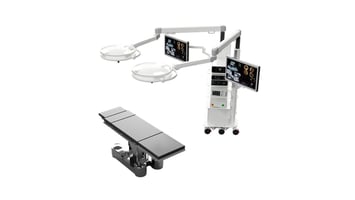Ambulatory Healthcare Design Lab (AHD*lab) seeks to explore innovations in healthcare design and...
Navigating the Maze of Codes and Regulations in Ambulatory Healthcare Design
Designing ambulatory healthcare facilities is complex and layered. In addition to creating aesthetically pleasing and highly functional spaces, one must ensure that the design complies with a labyrinth of codes, regulations, and standards that are in place to protect the safety and welfare of patients, staff, and visitors. With so many requirements to juggle, it can be tough to know where to start. The following is a brief overview of key codes, regulations, and standards to consider when designing ambulatory healthcare facilities, as well as some tips for navigating this maze and ensuring that your project meets the necessary requirements.
Local Zoning Regulations:
- Planning and Zoning: Whether building a new building or fitting out an existing tenant space, make sure your facility will comply with applicable zoning codes. Assure that the use is allowed and parking requirements will be met. In the case of a new building, additional land use regulations will need to be followed, including setbacks, site coverage, storm water management, and more.
State Building Codes:
- International Building Code (IBC): In use or adopted in 50 states, the District of Columbia, the U.S. Virgin Islands, Guam and the Northern Marianas Islands, the IBC sets minimum standards for structural integrity, fire safety, and other essential factors. At this link is a handy state map with references to the codes and editions adopted: https://www.iccsafe.org/wp-content/uploads/Code_Adoption_Maps.pdf
- Each state has its own healthcare facility regulations. For specific requirements, you can typically check the state's DOH website. While some states have unique design and construction guidelines, many adopt the following.
- FGI Guidelines: The Facility Guidelines Institute (FGI) Guidelines for Design and Construction of Outpatient Facilities is the minimum standard for ambulatory healthcare facilities. To see where the FGI Guidelines are in force, consult the Adoption Map at this link: https://www.fgiguidelines.org/guidelines/adoption-map/
- ASHRAE 170: Focuses on ventilation and indoor air quality in healthcare facilities, and is an Appendix to the FGI Guidelines.
- NFPA 101, Life Safety Code: This important code outlines fire and life safety requirements for building types, including Ambulatory Healthcare Facilities. It is also the standard referenced for compliance with CMS Conditions for Coverage. Limited free access is available online: https://www.nfpa.org/codes-and-standards/1/0/1/101
- NFPA 99: This standard addresses the minimum performance requirements for health care facilities, including medical gas and vacuum systems, electrical systems, gas equipment, and features of fire protection. It can also be referenced on the NFPA website.
Federal Regulations:
- Centers for Medicare and Medicaid Services (CMS): Familiarity with CMS standards for participation in Medicare and Medicaid programs may also be necessary. Guidance can be found here: https://www.cms.gov/medicare/health-safety-standards/guidance-for-laws-regulations
- Medicare Conditions for Coverage: These conditions outline minimum standards for healthcare facilities to receive Medicare and Medicaid reimbursement: https://www.cms.gov/medicare/health-safety-standards/conditions-coverage-participation
Accessibility:
- Americans with Disabilities Act (ADA): The ADA ensures equal access to facilities for people with disabilities. Designers must follow the ADA guidelines to create an accessible environment: https://www.ada.gov/
- State Specific Accessibility Codes: Some states, such as Massachusetts, Texas, and Florida, have accessibility codes unique to their states. Be sure to check the code standards for the state you are working in.
- AAAHC: Accreditation by the Accreditation Association for Ambulatory Health Care demonstrates a facility's commitment to quality care and patient safety. AAAHC and other accrediting agencies can also provide for Medicare certification through deemed status. It is important to be familiar with the accrediting/certifying body's specific requirements when designing an ambulatory healthcare facility. Link: https://www.aaahc.org/
- The Joint Commission: Similar to AAAHC, The Joint Commission offers accreditation and certification for certain ambulatory healthcare facilities. Link: https://www.jointcommission.org/
- AAAASF: The Ambulatory Association for Accreditation of Surgical Facilities tends to focus on accreditation of office based facilities, but also provides certification of ASC's and other facilities. Link: https://www.aaaasf.org/
Other Standards:
- ASHE: The American Society for Healthcare Engineering provides resources and standards for healthcare facility design, construction, and operations: https://www.ashe.org/
- AORN: The Association of periOperative Registered Nurses offers guidelines for operating room design and practices: https://www.aorn.org/
- AAMI: The Association for the Advancement of Medical Instrumentation sets standards for medical devices and equipment: https://www.aami.org/
While this list is comprehensive, it is not exhaustive, and requirements may vary depending on your location, facility type, and other factors. At the start of each project, it is good practice to verify the specific codes and regulations that will be in force where the project is located. Also, be sure to confirm which edition applies, as this can vary too.
Diligently navigating the maze of codes and regulations specific to your project will help create an ambulatory healthcare facility that is safe, compliant, and sound. Feel free to use this list as a guide as it may help jumpstart your process. Visit www.hsarchitecture.com and the Ambulatory Healthcare Design Lab for more examples and information on this compelling project type.






